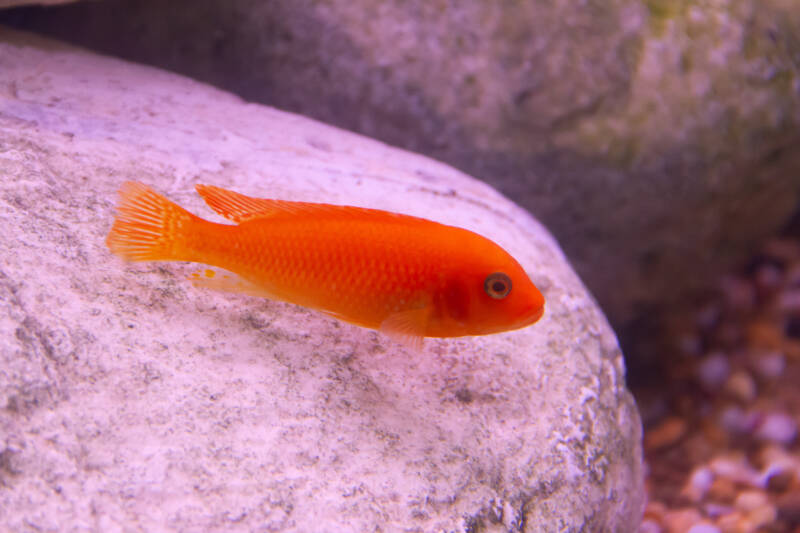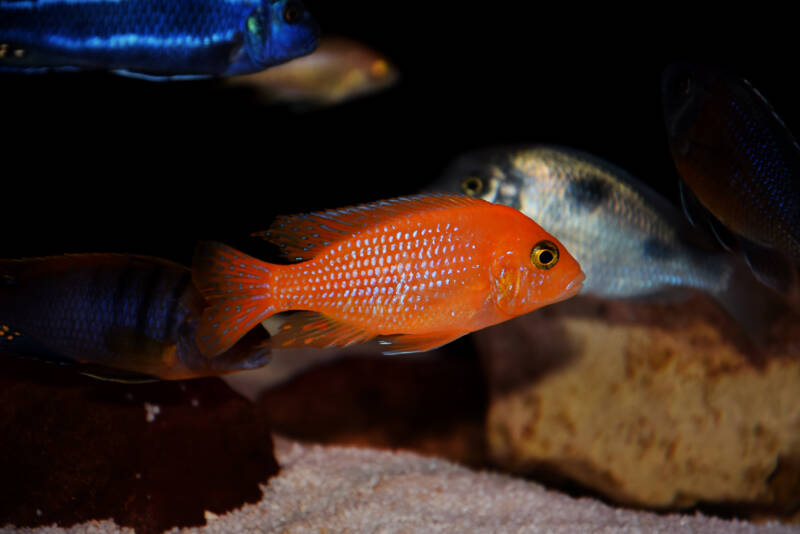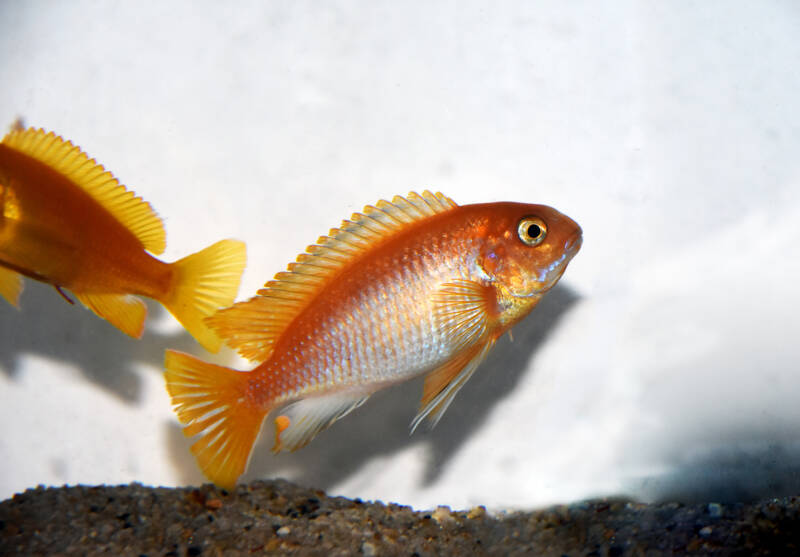If you like tropical fish with loads of color and personality, the red zebra cichlid will get your attention. The only thing these aggressive cichlids have in common with zebras is their African origin.
Red zebra cichlids are rock-dwelling mbunas that look amazing in freshwater aquariums with high pH and plenty of hardscape structure.

Read this article for all you need to know about keeping and caring for these stunning cichlids.
At A Glance
| Min tank size: | 55 gal (200 L) |
| Temperament: | semi-aggressive |
| Group size: | 4+ |
| Temperature: | 72-82°F (24-29°C) |
| pH: | 7.5-8.6 |
| Lifespan: | up to 10 years |
| Size: | up to 5 inches (12.5 cm) |
| Species: | Maylandia estherae, Metriaclima estherae |
[toc]
Natural Habitat
The red zebra cichlid is a freshwater fish from the rift valley region of East Africa.
This species comes from Lake Malawi and is found nowhere else. The lake is a massive body of water that lies south of the equator, forming the borders of Malawi, Mozambique, and Tanzania.
In this lake, red zebra cichlids occupy rocky and sandy areas with plenty of caves and cracks where they hide and feed.
The water in this lake is warm and notoriously alkaline, with a pH of over 8 and temperatures between about 75 and 84°F (24-29°C).
Size and Description

Red zebra cichlids are medium-sized fish that typically grow to around 5 inches (13 cm) in length.
The females are slightly smaller, reaching a maximum length of about 4 inches (10 cm).
The red zebra has a bit of a confusing name because they aren’t always red, and they don’t have stripes!
Most specimens in the aquarium hobby are orange-red, but the species is naturally variable in color.
Wild specimens can be found in a range of different color morphs, including:
- Blue
- Yellow
- Pink
- Brown
- Mottled.
Behavior
Red zebra cichlids are mbunas known for their fairly aggressive and territorial natures.
This behavior is important in nature where breeding sites are limited, and pairs must defend a territory.
They are a fish species that need careful research before introducing to any aquarium.
It is essential to house them in the correct tank size and with the appropriate tank mates to minimize their aggression.
Keep your red zebra cichlids in a shoal of at least four individuals. This should include one male and a harem of 3 or more females.
By keeping several females, you will be able to prevent any individual getting too much unwanted attention from the male.
Tank Setup
Let’s take a look at how to set up the ideal aquarium for your red zebra cichlids.
Tank Size
When it comes to choosing a tank size, select the largest size that you can afford, have space for, and are able to manage.
The minimum tank size for a small group of red zebra cichlids is 55 gallons (200 l).
Substrate and Decor
Provide plenty of space and rock structures like caves, tunnels, and rock piles in the tank to imitate a natural environment for these feisty fish. This also provides the fish with hiding spaces to escape any aggression.
Red zebra cichlids tend to shift small objects around in the tank. Therefore, a smooth sand or pebble substrate is ideal for the fish to safely “rearrange the furniture.”
This habit means they tend to dig up plants too, so the only really suitable options are epiphytes like java fern and Anubias species. These plants can be grown attached to your hardscape.
Filtration
Good filtration is the key to success with any aquarium. Canister filters are a great option for African cichlid aquariums because they do not take up any room in the aquarium.
This is handy because mbuna tanks are often overstocked to limit territorial aggression.
For the advised minimum tank size of 55 gallons, a canister filter like the Fluval 307 is a great option.
Alternatively, a hang-on back filter like the Marineland Penguin Prop 375 Power Filter can be used.
These filters create a flow rate of 300-375 gallons per hour. This is enough to keep the water in your tank well-filtered without creating too much current.
Lighting
Unless you plan on growing live plants in your aquarium, your choice of lighting will mostly be determined by your own preferences.
Standard fluorescent or LED aquarium lighting will work equally well.
Water Preferences
Red zebra cichlids have a preference for alkaline water with a pH of 7.5-8.6. They do well in hard water, up to 25 dGH.
Your aquarium should be fully cycled before introducing these fish since they will not tolerate ammonia and nitrites in the water.
A 25% weekly water change is a good starting point, but use your test kit to measure nitrate levels. Ideally, you would like to keep this level to below 20 ppm.
Tank Mates and Compatibility

Selecting suitable tank mates for African cichlids can be a bit of a challenge – most common aquarium fish will not make good tank mates.
There are, however, a few species that have been kept successfully with red zebra cichlids.
The Malawi spotted syno catfish (Synodontis njassae) is a great option because it is also native to Lake Malawi and thrives in the same water conditions.
Some aquarists have also had success with bottom dwellers like bristlenose plecos and clown loaches. Provide these fish with a good hiding place like a cave if they encounter any aggression.
It is also best to add your pleco or loach to the tank before or soon after you introduce the cichlids.
However, without a doubt, the best tank mate options are groups of other mbunas that have similar natures and are able to stand up to their tank mates.
Even then, you should always have a backup plan in case a new introduction doesn’t go smoothly.
Some possible options include:
- Labidochromis caeruleus
- Melanochromis johannii
- Pseudotropheus socolofi.
Food & Diet
Red zebra cichlids are omnivorous fish, which means they feed on both plant and animal matter.
Algae form an important part of their diet, but they are opportunistic and will take small insects and other invertebrates when they get the chance.
Feed your red zebra cichlids three or four times a day. Frequent feeding can be very helpful in reducing aggression between your cichlids.
They are greedy fish, however, so limit the amount of food in each feeding to what they can finish in about 30 seconds.
To provide your red zebras with the nutrition they need, feed them a staple diet of spirulina algae flakes or pellets. A product like New Life Spectrum Cichlid is a good option as a daily food source.
The following are also great supplementary food sources:
- Lettuce
- Spinach
- Duckweed.
Red zebra cichlids are voracious algae-eaters, which is great because they will help to keep your tank clean.
Natural algae growth in the tank will be fed on by the fish. The fry can be fed on baby brine shrimp or micro worms.
High protein diets and overfeeding should be avoided as they can result in serious health conditions and obesity.
Sexing and Breeding
As a group, cichlids have some pretty amazing breeding strategies and rituals. The red zebra is no exception.
These fish take parental care to the next level by mouthbrooding their eggs and fry.
It is difficult to sex red zebra cichlids because their colors are variable.
Generally, the males grow a little larger and have four to seven egg spots on the anal fin. Female red zebra cichlids typically have a more rounded anal fin with three or less.
These fish are not difficult to breed in a home aquarium.
The male will prepare a nest in the substrate and display it to entice a female. If a female accepts his offer, she will lay her eggs in the nest before taking them up into her mouth.
The spots on the male’s fins look like her eggs, and she will try to take them too, resulting in fertilization by the male.
She will keep the eggs and fry in her mouth for as long as a month before allowing them to swim freely in the tank.
Hardiness and Diseases
Red zebra cichlids are hardy fish if kept in the appropriate water parameters, tank size, and with the right diet and tankmates. They can, however, be affected by a few common diseases.
Malawi bloat is a notorious infection of African cichlids. It is thought to be triggered by stress caused by incorrect diet and water conditions.
Other potential issues include:
- Hexamita
- Swim bladder diseases
- Ich
- Flukes.
Closing Thoughts
All in all, the red zebra cichlid is an amazing aquarium fish for intermediate to advanced aquarists.
These fish are usually available for less than $10 each, depending on their size and color variety.
They are the kind of fish that need to be planned for and not simply added to a community tank.
However, there’s no reason you can’t start with these fish as a beginner. Just be sure to put in the time, effort, and resources to get them started in the right way.
Do you keep red zebras? Let us know about your experiences with them below!
